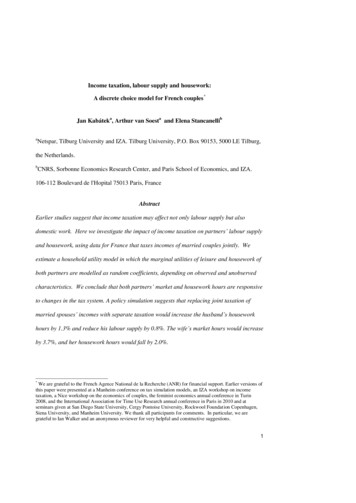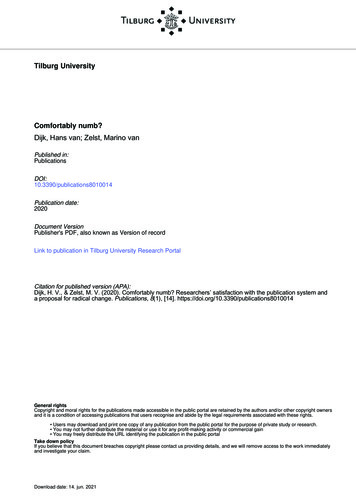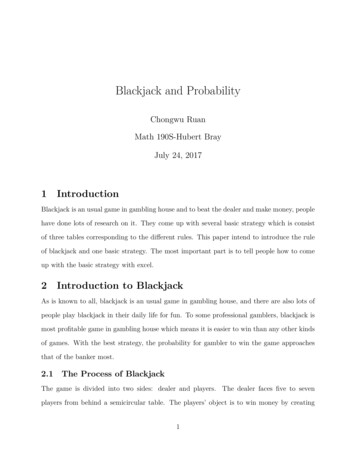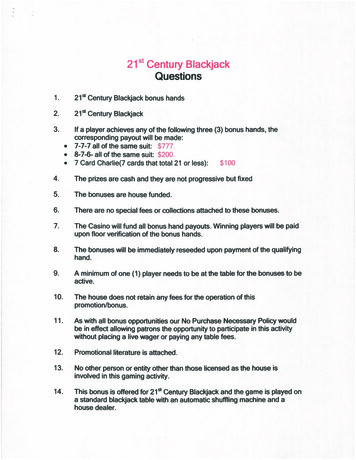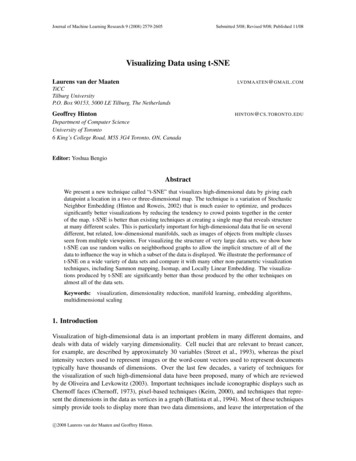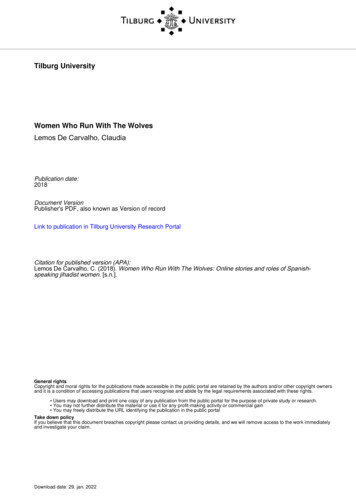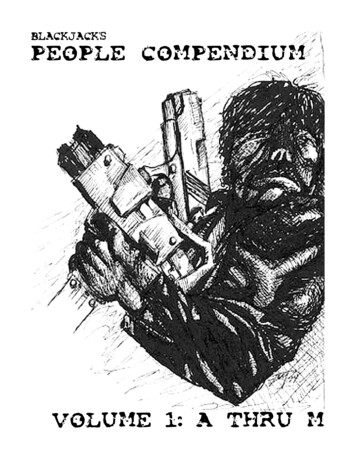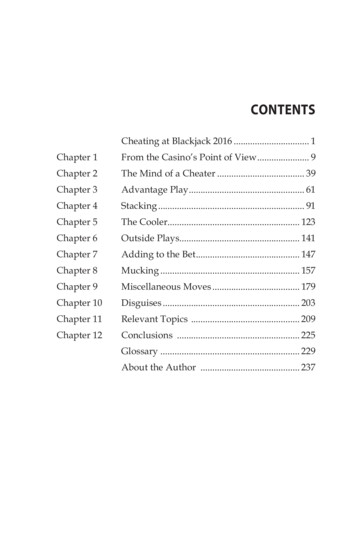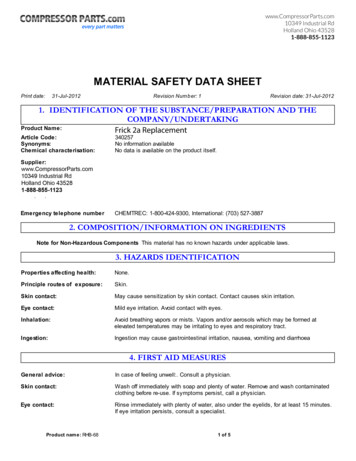
Transcription
Tilburg UniversityBlackjack in Holland Casino'svan der Genugten, B.B.Publication date:1995Link to publication in Tilburg University Research PortalCitation for published version (APA):van der Genugten, B. B. (1995). Blackjack in Holland Casino's: Basic, optimal and winning strategies. (Researchmemorandum / Tilburg University, Faculty of Economics and Business Administration; Vol. FEW 711). UnknownPublisher.General rightsCopyright and moral rights for the publications made accessible in the public portal are retained by the authors and/or other copyright ownersand it is a condition of accessing publications that users recognise and abide by the legal requirements associated with these rights. Users may download and print one copy of any publication from the public portal for the purpose of private study or research. You may not further distribute the material or use it for any profit-making activity or commercial gain You may freely distribute the URL identifying the publication in the public portalTake down policyIf you believe that this document breaches copyright please contact us providing details, and we will remove access to the work immediatelyand investigate your claim.Download date: 02. jul. 2022
Blackjack in Holland Casino’s:basic, optimal and winning strategies.B.B. van der Genugten November 1995AbstractThis paper considers the cardgame Blackjack according to the rules of HollandCasino’s in the Netherlands. Expected gains of strategies are derived with simulation and also with analytic tools. New efficiency concepts based on the gains ofthe basic and the optimal strategy are introduced. A general method for approximating expected gains for strategies based on card counting systems is developed.In particular it is shown how Thorp’s Ten Count system and the High Low systemshould be used in order to get positive expected gains. This implies that in HollandCasino’s it is possible to beat the dealer in practice.Keywords: blackjack, Holland Casino’s, cardgames, basic strategy, optimality, cardcounting, Ten Count system, High-Low systemAMS classification: 60E05, 62J05. Department of Econometrics, Tilburg University, Tilburg, The Netherlands.
11IntroductionThe cardgame of Blackjack (also known as Twenty One) is still today one of the mostpopular casino games. It has engendered much interest since by clever play it is possiblefor players to get an advantage over the house. This discovery was revealed in the sixtieswith the publication of the paper Thorp (1960) and the subsequent famous book Thorp(1966) entitled ”Beat the Dealer”. Thorp showed that the player’s expectation variesaccording to the undealt cards, and he indicated how to identify situations with a positiveexpectation. By raising the bet in such games an overall positive expected result can beobtained. Such winning strategies will beat the dealer in the long run.However, casino’s took their counter measures and changed the rules in order to getthe advantage back. Today, these rules vary strongly between and even within casino’s.For most of the variations it is still possible to obtain a serious advantage for professionalhard working card counters. Although this mere fact seems to disturb casino boardsterribly, the game is still attractive to exploit because most players are really amateursand lose a lot of money. Another reason is that a winning strategy for one version of thegame is a losing one for another variation.There is a tremendous literature available on BJ (Blackjack). A lot of books arefilled with strategy tables to use. Some of them are unreliable because they are basedon rough approximating probability calculations; even the class of game variations forwhich they are supposed to be appropriate is not clearly indicated. The serious ultimateguide for references is Dalton (1993). We mention here the easily available and reliablemathematical books and papers Baldwin et. al. (1956), Epstein (1977), Gottlieb (1985),Griffin (1988), Chambliss and Roginski (1990), Yakowitz and Kollier (1992), and theappendix of Black (1993). All these publications deal exclusively with the American wayof playing: with a dealer’s hole card. In Europe in most casino’s the game is playedwithout a hole card.The goal of this paper is to give a profound analysis of Blackjack as it is playedin Holland Casino’s in the Netherlands (Amsterdam, Breda, Eindhoven, Groningen,Nijmegen, Rotterdam, Scheveningen, Valkenburg, Zandvoort and Schiphol Airport).These BJHC-rules are exactly the same in all cities. They are typical Dutch in so farthat the precise combination of the variations does not appear elsewhere. (We willdescribe the rules exactly in section 2.) Shortly, the differences with the Las Vegas Stripstandard (see Dalton (1993), p. 65) are: all cards dealt face up and no hole card (theEuropean way), a six-deck shoe with a cut card between 1/2 and 2/3, restrictions fordoubling on card combinations, doubling after splitting, unrestricted repeated splitting(for splitted aces one card only), and a three-sevens bonus. As in Las Vegas there is no
2(early or late) surrender. Experiments are going on in Amsterdam and Zandvoort withcard shuffling machines, leading to games that are more or less played with completeshoes only.A keystone for professional playing is the so called basic strategy. This strategy forBJHC was published first in Van der Genugten (1993). Thereafter this strategy wasrevealed (and derived independently) by two Dutch professional Blackjack players Windand Wind (1994).In this paper we will analyse strategies for the BJHC-game and the concepts on whichthey are based. Utmost care is taken to give a clear definition of them since in literaturethis is often a source of confusion. Results are obtained with a special purpose computerpackage. It consists of 5 interrelated computer programs written in Turbo-Pascal:- BJ1SIM: a highly flexible simulation program for obtaining expected gains for(combinations of) arbitrary strategies,- BJ1ISTRT, BJ1FSTRT: two analytic programs which calculate expected gains fora given stock and a given strategy; I (nfinite) indicates drawing with replacementand F(inite) stands for drawing without replacement,- BJ1IGAME, BJ1FGAME: two analytic programs which calculate optimal expected gains and corresponding optimal decision tables; here I and F have the samemeaning as before.Much of the material in this paper is, with minor changes, applicable to rules inother European casino’s. For rules outside Europe differences are somewhat bigger dueto the presence of the hole-card.The paper is organized as follows. In section 2 we give a description of the rules ofBJHC.In section 3 we discuss the two components of strategies: the betfunction and theplaying strategy. We formulate precisely the concept of optimality. This leads to asound definition of the basic strategy. To fix the ideas we have also included its decisiontable in this section.In section 4 we consider the expected gains of strategies. By means of BJ1SIM wecan give these gains for some naive strategies and the basic strategy. Also some roughestimates are given for the optimal strategy. We conclude this section by introducingefficiency concepts for arbitrary strategies.
3The steady-state analysis in section 5 makes clear which tools are needed for computercalculations for expected gains. These tools in the form of computer programs aredescribed in the following two sections.Section 6 describes the programs BJ1IGAME (for the construction of the optimalstrategy) and BJ1ISTRT (for given arbitrary strategies) under the assumptions thatcards are drawn with replacement. In particular it contains the construction of the basicstrategy.Section 7 describes the corresponding programs BJ1FGAME and BJ1FSTRT for thepractical situation that cards are drawn without replacement. As far as we know thecoding system needed for doing actual calculations has never appeared in literaturebefore.In section 8 a method is given for estimating the expected gains for arbitrary strategies, in particular for the basic strategy and the optimal strategy. These estimationmethod only gives crude estimates due to the fact that the sample size is rather smallbut yet too large to prevent replacement of approximations with BJ1IGAME by the(more ore less) exact values with BJ1FGAME.In section 9 we follow another approach by means of (linear and non-linear) approximations of expected gains by card fractions. Here we describe the general setup andits relations to card counting systems for betting. Analytic results can be obtained byapproximating the distribution of the running count by that of the Brownian bridge.In section 10 we consider card counting systems more in detail. We restrict ourselvesto a discussion of TTC (Thorp’s Ten Count) and HiLo (High-Low).Finally, in section 11 we describe how the card counting systems of section 10 can beused for playing decisions. Since optimal betting often involves maximal bets, high budgets are needed. Therefore we consider also some other betting concepts more suitablefor low budget players. For readers only interested in practical strategies which beat thedealer this is the most interesting section.2BJHC-rulesIn this section we will give a description of the BJHC-rules together with some notationto be used in the following. Game constants for which we will consider alternatives arepresented as variables together with their standard values.BJHC is a card game that is played with 2-7 players; mostly the number of players isa 7. The dealer, who is a member of the house, deals the cards out of a device calleda shoe. A complete shoe consists of n 6 decks of playing cards of size 52 (therefore in
4total k 52n 312 cards).Cards are always dealt face up. So, at least in theory, every player can know the composition of the shoe at any stage of the game by observing the dealt cards.Face cards have the value 10 (T); non-face cards have their indicated value. An A(ace) is counted as 1 or 11 depending on the other cards in the hand. If the sum of ahand with at least one ace counted as 11 would exceed 21, then all aces are counted as1, otherwise one ace is counted as 11. A hand or sum is called soft if it contains an acecounted as 11; otherwise it is called hard. The main goal of players is to get hands witha sum as close as possible to but never exceeding 21 by drawing (asking the dealer forcards one after another) or standing (requesting no more cards) at the right moment.He busts (loses) if his (hard) sum exceeds 21. After all players the dealer draws cardstoo. He has no choice at all: he draws on sums 16, stands on sums 17 and 21(hard or soft) and busts (loses) on a (hard) sum 21. If a player and the dealerboth stand, then the game is lost for the one holding the smallest sum. The combination (A, T) is called ”Blackjack” and beats any other sum of 21. Equals sums give a draw.We code cards by their value and the ace by 1. In general the card distribution in the shoeat a certain stage of the game is random and will be denoted by C (C(1), . . . , C(10)).Realizations will be denoted correspondingly with c (c(1), . . . , c(10)).The playing stock C1 for the first game is the (non-random) complete shoe c0 (kp1 , kp2 , . . . , kp10) (4n, 4n, . . . , 4n, 9n) (24, 24, . . . , 24, 96), where p1 · · · p9 1/13, p10 4/13 are the cards fractions in one deck. The remaining cards in the shoeafter the first game become the (random) playing stock C2 of the second game and soon. Used cards are placed into a discard rack. If during (or at the end of) a game thePsize C(i) of the current stock C in the shoe decreases to a level equal to or less thank(1 λ), then after this game the cards are reshuffled and the next game starts againwith a complete shoe. In practice the fraction is marked by positioning a cut card in theshoe at about a played fraction λ 2/3 corresponding to a level of 104 remaining cards.However, in BJHC dealers are allowed to lower the cut card position to λ 1/2. Thisappears to be a disadvantage for the players and is only done when professional cardcounters join the game. We call a rowgame a whole sequence of games, from a completeshoe up to the game in which cut card falls or is reached.At this moment the HC’s in Amsterdam and Zandvoort are experimenting with cardshuffling machines. After each game cards are automatically reshuffled. In this casea rowgame consists of exactly one game. If this reshuffling would be completely ran-
5dom, this would correspond to BJ with a fraction λ 0. (In practice there is a slightcorrelation between successive drawings.)Outside the Netherlands there are still casino’s which offer Blackjack without a cutcard. This corresponds to a fraction λ 1. For that case, and also for other high valuesof λ, the shoe will get empty during a game. Then the cards in the discard rack arereshuffled and placed into the shoe for playing the remaining part of the game. In thispaper we assume that then the next game is started with a reshuffled complete shoe. InBJHC the discard rack is never used for this purpose because the cut card position λ istoo small. However, for a general description and analysis it is worthful to consider thewhole range λ [0, 1].We describe in detail one game together with the decision points of the players.The game starts with the betting of the players. The minimum and maximum bet canvary with the table. Today in BJHC the possible combinations (in Dutch guilders) are(10, 500), (20, 1000), (40, 1500) and in the ”cercle privé” (100, 2500) (the combination(5, 500) in Scheveningen no longer exists). Fixing the minimum bet at the unit amountBmin 1, the possible values of the maximum bets are Bmax 50, 37.5 and 25. Betsmust be in the range [1, Bmax ].After the player’s betting round the dealer gives one card to each of the players andto himself (the dealercard). Then a second card is dealt to each of the players to makeit a pair (not yet the dealer). So at this stage all hands of players contain two cards.If the dealercard is an A, every player may ask for insurance (IS) against a possibledealer’s ”Blackjack” later on. This is a side bet with an amount 12 his original bet.A player with the card combination ”Blackjack” has to stand.Next, players without ”Blackjack”, continue playing their hand, one after another,from player 1 to a.If both cards of a hand have the same value, a player may split (SP) those cards andcontinue separately with two hands containing one card. To the additional hand a newbet equal to the original bet must be added. The first step in playing a splitted handis that the dealer adds one new card to make it a pair. Repeated splitting is allowedwithout any restriction. However, with a no further splitted hand of two aces standingis obligatory. Splitted pairs cannot count as ”Blackjack”.If a pair (splitted or not) has a hard sum 9, 10 or 11 or a soft sum 19, 20 or 21 (notBlackjack), doubling down (DD) is permitted. Then the player doubles his original bet,draws exactly one card and has to stand thereafter. A soft sum becomes hard becauseevery ace in this hand gets automatically the value 1.
6Finally, if a hand is not doubled, the player can draw or stand (D/S) as long as he didnot stand or bust. Standing on a (hard or soft) 21 is obligatory. A non-splitted hand ofthree sevens gets a bonus of 1 the original bet.After all players have played their hands the dealer draws cards for himself accordingto the fixed rule already indicated.A winning player gains an amount 1 his original bet and even 1 12 if he wins with”Blackjack”. A losing player loses his bet. In case of a draw a player gains nor loses: hisbet is returned.If at least one player has taken insurance against a dealer’s ace then, even in thecase that no player stands, the dealer must draw at least one card to see if he gets”Blackjack”. If he has ”Blackjack” then the player gains 2 his insurance, otherwisehe loses this insurance. In practice, if a player insures his own ”Blackjack”, he alwaysgains 1 his bet. Therefore, the dealer gives him immediately this gain and removesthe player’s cards from the table. This particular form of insurance is called evenmoney.(Of course, for evenmoney alone the dealer would not draw a card.)In the following we consider the number of decks n, the cut card position λ, thenumber of players a and the maximum bet Bmax as parameters. For the standard valuesn 6, λ 2/3, a 7 the time needed for one game is about 1 minute. Reshuffling takes2 minutes. Since one rowgame contains approximately 10 games, this gives 12 minutesper rowgame or 5 rowgames per hour. So a professional player can play 10000 rowgames(or 100000 games) yearly if he works hard for 2000 hours per year. This should be keptin mind in judging expected gains per (row)game of strategies. For theoretical purposesconcerning approximations we will also consider games in which every card is drawn withreplacement. We refer to these games by the parameter values n and λ 0. Thisimplies that rowgames coincide with games.3Strategies and optimalityConsider a game with fixed parameters n, a, λ and Bmax . A strategy (Hν , Sν ) for a playerν consists of two parts: a betting strategy Hν which prescribes the betsize at the start ofeach new game and a playing strategy Sν which prescribes the playing decisions IS, SP,DD, D/S at any stage of the game.We restrict the class of all possible strategies of a player ν in the following way. Hisbetsize at the start of a game shall only depend on the stock at that moment; thereforeit can be characterized by a betfunction Hν (c) [1, Bmax ], c C, with C {c0 } {c :
7Pc(i) k(1 λ)} the class of possible stocks which can be encountered with betting.The playing decisions of the player ν at a certain stage of the game shall only dependon the current or past stocks in that game and the exposed cards on the table at thatstage. So a playing strategy Sν is a function which specifies the playing decisions forevery possible sequence of stocks and table cards during a game. More precisely, let d0 (c)denotes the sequence of the 2a 1 cards dealt by the dealer (ν 0) before the playinground starts, dν (c) (for ν 0, . . . , a) the whole sequence of cards used by the players0, . . . , ν and, more specific, dνj (dν 1 (c), x1ν , . . . , xjν ) the sequence up to the stage inwhich player ν already got additionally j cards x1ν , . . . , xjν . Then Sν (dνj ) prescribesthe relevant playing decision at any stage dνj . This constitutes a class Sν of playingstrategies. The stocks during successive games only depend on the playing strategiesSν Sν for ν 1, . . . , a of the players and not on their betfunctions. The restriction tosuch playing strategies gives no loss of generality at all.Denote by G1 (c) the (random) gain of a player ν for a game with starting stock c Cand minimum bet Bmin 1. Then the (random) gain G(c) of this player using thebetfunction H(c) is given by G(c) H(c)G1 (c), c C.For given playing strategies S1 , . . . , Sa the probability distribution L(G(c)) is fixed.Given these strategies we call the betfunction Hν of player ν optimal if it maximizesE(G(c)) for every c C. Clearly, Hν is optimal for Hν (c) 1if E(G1 (c)) 0Bmax if E(G1 (c)) 0.For fixed Sj , j 6 ν, the distribution L(G1 (c)) only depends on the choice Sν Sν .Given the Sj with j 6 ν we call the playing strategy Sν optimal if Sν (dνj ) maximizesE(G1 (c) dνj ) for every stage dνj of the game that can be reached by player ν and forevery stock c C.Optimality for player ν depends on the playing strategies Sj of other players as well.In analyzing strategies for player ν we must make a specific choice for the playing strategies of the other players. A reasonable and pragmatic approach is to consider possibleimprovements of player ν amid other players of moderate skill playing independently ofeach other and following a simple so called basic strategy. Although in practice moderate players do not quite reach the level of this strategy, we choose it as a well definedreference point (see e.g. Bond (1974), Keren and Wagenaar (1985), Wagenaar (1988),Chau and Phillips (1995)).We define the basic strategy Sbas as the playing strategy which would be optimalunder the theoretical assumption that all cards are drawn with replacement (i.e. the
8game with n and λ 0). Clearly, under this assumption E(G1 (c0 ) dνj ) will onlydepend on dνj through the dealercard and the cards in the hand(s) of player ν and notof the playing strategies Sj of the other players j 6 ν. Therefore Sbas is the same for allplayers and can be tabulated as a function of the dealercard and characteristics of theplayer’s hand. We describe its construction in section 6. Table 1 gives the result.So from now on while evaluating numerically the quality of the strategy of a particularplayer we assume that the other players follow the basic strategy Sbas . Therefore theoptimal playing strategy Sopt will only depend on the number of decks n, the number ofplayers a, the cut card position λ and the particular player ν. We denote by Hbas , Hoptthe optimal betfunctions belonging to Sbas , Sopt , respectively. These functions depend onBmax too.4Expected gains and efficiencyConsider fixed parameters n, a, λ and Bmax . For a fixed choice of playing strategies foreach player, we consider the expected gain of a particular player with strategy (H, S).The random sequence of all successive stocks by dealing one card after another duringthe mth game starting with stock Cm and ending with Cm 1 determines the gain Gm ofthe mth game. Then the average gain µG µG (H, S) per game in the long run is givenbym1 XµG limGi , a.s.(1)m mi 1(The average bet µB µB (H, S) per game in the log run is defined similarly). LetGRm be the sum of all gains in the mth rowgame and Nm the number of games in thisrowgame. Then the average gain µGR and number of games µN per rowgame is given byM1 X(µGR , µN ) lim(GRm , Nm ), a.s.(2)M Mm 1Clearly,µG µGR /µN .(3)
9Table 1. Basic Strategy Sbas of BJHCINSURANCE: never t X; No Split )A 2 3 4 5 6 7 XXX XXXX XXX XXXX XXX XXXX DOUBLE DOWN (DDown Dealercard A 2 3 4SumHard 9 X XHard 10 X X XHard 11 X X XSoft 19-21 DRAW/STANDDealercard ASumHard 11 XHard 12XHard 13XHard 14XHard 15XHard 16XHard 17 Soft 17Soft 18Soft 19XX XXXX XXXX XXXX XXXX XXX XX 89TX XX X XX X X; No DDown )5 6 7 8 9 T XX XX (Draw X; Stand )2 3 4 5 6 7 89TXXXXXX XXXXXX XX XXX XXX XX X X X X X X X X XX XXXXXX XXXXXX X X X XX X
10The simulation program BJ1SIM estimates for any given playing strategy and anysimulation run of M rowgames the values of µGR , µN and µG . The reliability of thesimulation depends strongly on the quality of the random generator. The simulationprogram is written in Turbo-Pascal. Its builtin random generator is based on a linearcongruent method with a cyclus that would give reliable results for a length of about300-400 rowgames with 7 players. Therefore, as an alternative, an algorithm of Baysand Durham is used exactly in the way as indicated in Press et al. (1989), section 7.1,p. 215; see also Van der Genugten (1993), section 2.2.7, p. 106 for more details. For areasonable accuracy a simulation lengh of about M 50,000,000 rowgames is needed.On a PC-Pentium 90 such a simulation run requires 4 days.In order to give an idea about the losses that are suffered with simple naive strategieswe performed a simulation for BJHC with a 7 players, giving player ν the naivestrategy ”stand if sum ν 11 and draw otherwise”. The strategy ”stand for sum 12” means ”never bust” and ”stand for sum 17” is called ”mimic the dealer”. Thebetsize is 1.Table 2. Sim. gains of naive playing strategies (n 6, λ 2/3, a 7, H 1)playing strategy: never IS, SP or DD; S if sum ν 11 and D otherwise(M 50,200,000 rowgames µN 10.13 games)PνµGR 95% CIµG (1, Sν 11 )DP5P4P6P3P2P1P74.622 0.524 0.527 0.571 0.586 0.688 0.814 2 0.0517 0.0521 0.0564 0.0579 0.0679 0.0804 0.0899In the first column the player D refers to the dealer and Pν to player ν. Thethird column contains the half length of a 95% confidence interval for µGR . We see thatthese simple strategies lead to a disaster. Even the relatively best player P5 standingon 16 suffers a loss of more than 5%. This is much more than a pure chance gameas Roulette would cost! Certainly such players are welcome at the Blackjack tables in HC.
11All players can do much better with a little bit more effort by following the basicstrategy. Since the use of pencil and paper is strictly forbidden in BJHC, they just haveto learn table 1 by heart. A simulation result with BJ1SIM is given in table 3.Table 3. Sim. gains of Sbas (n 6, λ 2/3, a 7, H 1)playing strategy: see table 1(M 50,000,000 rowgames µN 9.86 games)PDP5P2P6P4P7P3P1µGR 95% CIµG (1, Sbas )0.3726 0.053 0.053 0.053 0.053 0.054 0.054 8 0.0054 0.0054 0.0054 0.0054 0.0054 0.0054 0.0055We see that µG(1, Sbas ) 0.0054 is almost the same for all players and therefore independent of the position at the table. Although the value is still negative it ismuch better than the values of µG for the naive strategies in table 2.The gain µG (1, Sbas ) for the basic strategy does hardly depend on the number ofplayers. Table 4 gives the simulation result for 1 instead of 7 players.Table 4. Sim. gains of Sbas (n 6, λ 2/3, a 1, H 1)(M 1,000,000,000 rowgames µN 39.5 games)P1µGR 95% CIµG (1, Sbas ) 0.2170.001 0.0050This value differs slighly from µG (1, Sbas ) 0.0054 for n 6, λ 2/3, a 7.Roughly spoken, the basic strategy with bet 1 gives a loss of 0.0050 to 0.0055 for allplayers and is independent of the number of players a.Rather crude estimates of µG can be given for the optimal betfunctions Hbas , Hoptin combination with the playing strategies Sbas , Sopt. Table 5 gives some results for aparticular player, thereby assuming that the other players play the basic strategy. Inthe following sections we will discuss the accuracy of these figures in detail.
12Table 5. Estimated gains (n 6, λ 2/3, Bmax 50)StrategyµG(1, Sbas )(1, Sopt )(Hbas , Sbas )(Hopt , Sopt ) 0.005 0.004 0.08 0.11The table shows that there exist strategies (H, S) with positive expected gains.Using such strategies will beat the dealer in the long run.Consider for fixed playing strategies of the other players the strategy (H, S) of aparticular player. We define the total efficiency TE(H, S), the betting efficiency BE(H, S)and the (playing) strategy efficiency SE(H, S) SE(S) by, respectively,µG (H, S) µG (1, Sbas )µG (Hopt , Sopt ) µG(1, Sbas )µG (H, S) µG (1, S)BE(H, S) µG (Hopt , Sopt ) µG(1, S)µG (1, S) µG(1, Sbas )SE(S) .µG (1, Sopt ) µG (1, Sbas )TE(H, S) Clearly,TE(H, S) BE(H, S) TM.SE(S).(1 BE(H, S)),where TM is the table multiplier (not depending on S) defined byTM µG (1, Sopt ) µG (1, Sbas ).µG (Hopt , Sopt ) µG (1, Sbas )For obtaining a high betting efficiency of the strategy (H, S) we see that much effortshould be put into the approximation H of the optimal betfunction Hbas in a simpleplayable way; the improvement of the playing strategy S from Sbas towards Sopt is lessimportant. This is even more true when the table multiplier TM is small. Then thetotal efficiency TE of (H, S) is almost completely determined by its betting efficiencyBE. So the improvement of S towards Sopt for influencing SE is of minor importance.
13For n 6 and Bmax [25, 50], λ [1/2, 2/3] the table multipliers TM of BJHC arein the range 0.01 TM 0.03 and therefore very small. (The figures in table 5 arein agreement with this.) In fact the large number of decks n 6 has for a great dealreduced the effect of skill to betting.5Steady-state analysisConsider a fixed choice of playing strategies. The random sequence C1 , C2, . . . of startingstocks form an ergodic Markov chain with state space C and initial value C1 c0 . Denotebyπ(c) m lim P {Cm c}, c C(4)its limit distribution (independent of c0 ). We can express the average gains in the longrun as expectations of gains in only one game if we start this game with a random stockC1 C with L(C) π (the steady state). Then for G1 G1 (C) and G G(C) H(C)G1 (C) we have according to the LLN for Markov chains:XµG1 E(G1 ) π(c)E(G1(c))(5)c Cand more general,µG E(G) Xπ(c)H(c)E(G1 (c)).(6)c CSo, at least in theory, we can use (6) for calculating the expected gain µG of any betfunction H by determining π(c) and E(G1 (c)), c C.In evaluating numerically the strategy of a particular player we take for π the limitprobabilities for the assumed standard case that all players follow Sbas . So we neglectthe effect that π will change when the particular player deviates from Sbas . In practicethis effect is small and good approximations will be obtained. Neglecting this effect, wesee from (5) that the playing strategy Sopt of a player as defined in section 3 maximizeshis µG1 . The corresponding betfunction Hopt (depending on Sopt ) maximizes his µG in(6). The same holds for the optimal betfunction Hbas corresponding to Sbas .For BJ with a 1 player we can calculate E(G1 (c) d1j ) for every c C and forevery card sequence d1j of the player. This can be done not only for a given playingstrategy but also for the optimal strategy. We distinguish the cases n (drawingwith replacement) and n (drawing without replacement).For n the calculations are relatively simple because the card fractions in thestock remain unchanged. The computer programs BJ1IGAME and BJ1ISTRT solve theproblems for a given stock c in about 0.5 sec. on a PC-P
A keystone for professional playing is the so called basic strategy. This strategy for BJHC was published rst in Van der Genugten (1993). Thereafter this strategy was revealed (and derived independently) by two Dutch professional Blackjack players Wind and Wind (1994). In this paper we will analyse strategies for the BJHC-game and the concepts .
